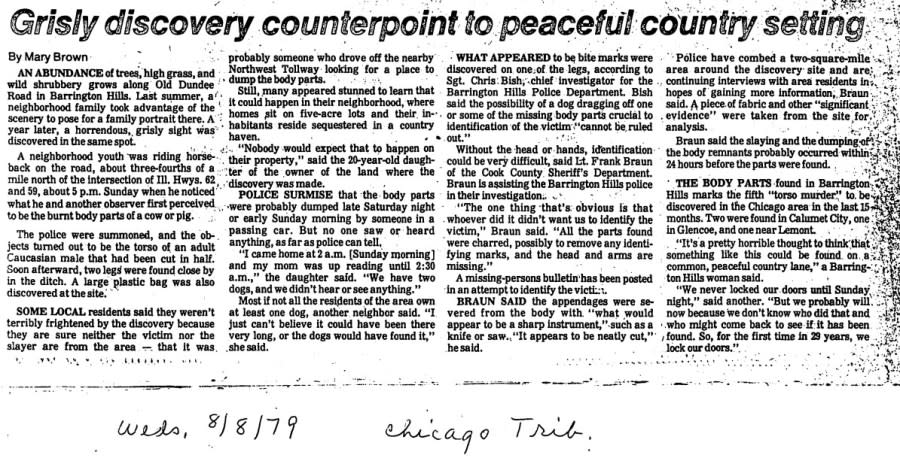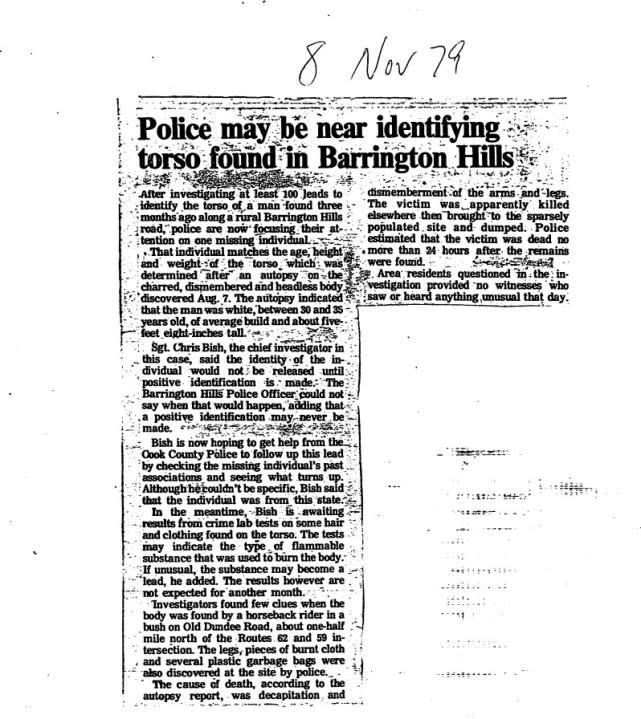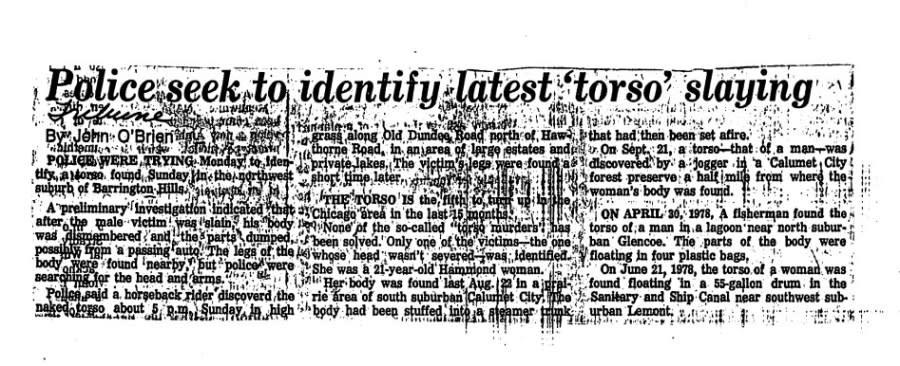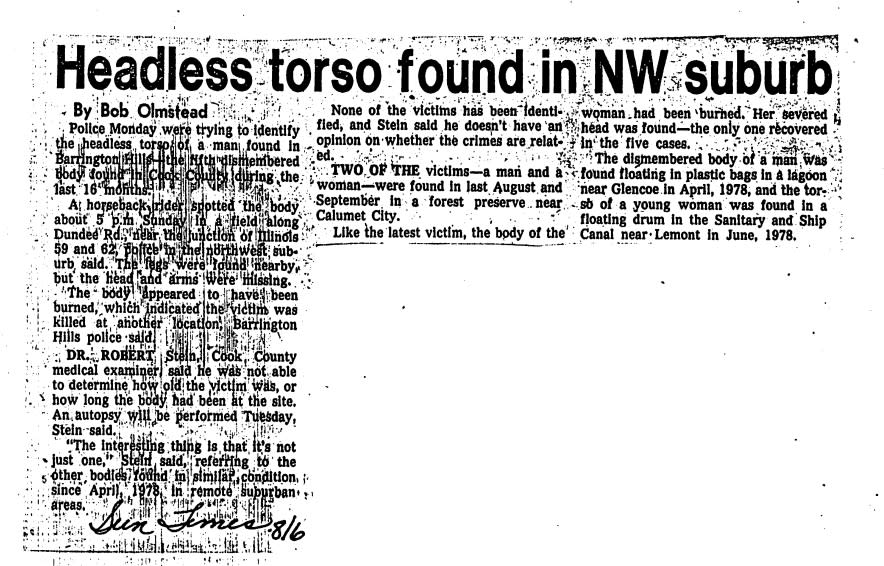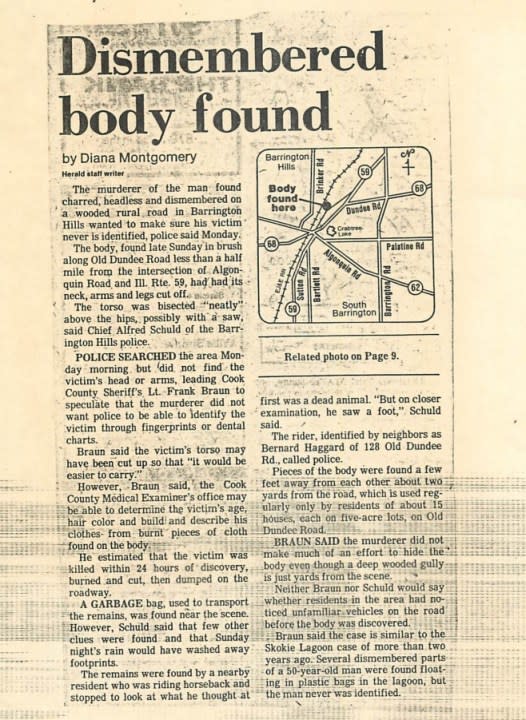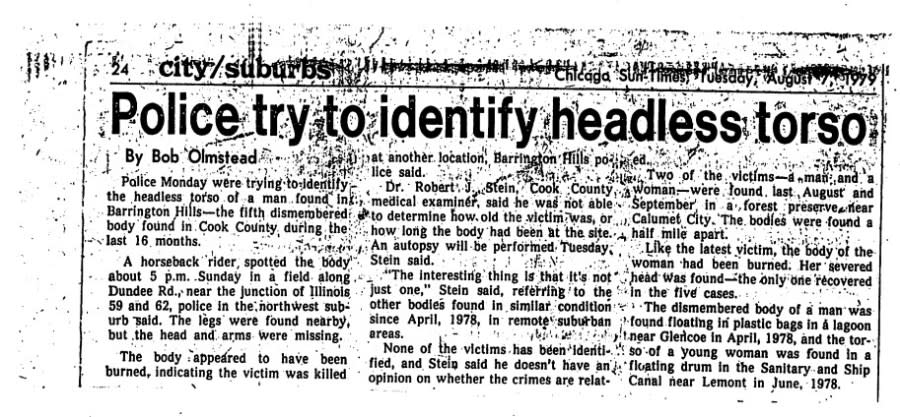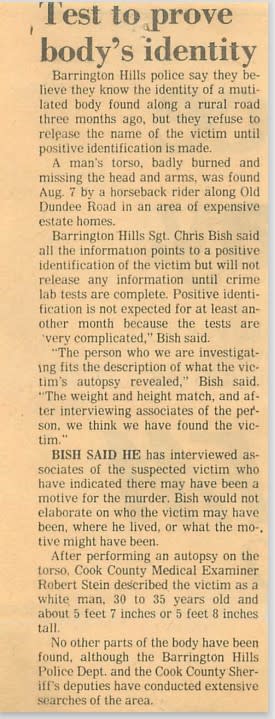‘You found my brother’: Man’s torso found 44 years ago in Barrington Hills now identified
BARRINGTON HILLS, Ill. — The torso of a man discovered 44 years ago in Barrington Hills has been identified thanks to new technology from a private company.
The torso was found on Aug. 5, 1979, in a quiet neighborhood by a boy horseback riding in a wooded area about a mile down from Route 59 and Dundee Road.
Officers found the decapitated body, of a man who was 27 at the time, had been burned. His head and arms were missing.



“It was on a Sunday,” former Barrington Hill Police Chief Al Schuld said. “I was cutting my lawn at the time when I got the call and I come out and it was just chaos right after that.”
Schuld was police chief at the time of the discovery.
“It was hard to recognize for one thing because it was burnt,” Schuld said. “I can still remember the smell. The upper torso, then the bottom part of the torso and then the legs were there but there were no hands or head or nothing like that. The whole area was checked but we never did find that.”
After an examination, the Cook County Medical Examiner’s Office estimated the man was around 30 years old and about 5 feet 8 inches tall.
“It was like, oh my god, why would, how could somebody do that to a human being?” Schuld said.
Police at the time combed through missing persons reports trying to find a match.
“Cause of detectives, they worked constantly on it,” Schuld said. “Lead after lead after lead, and you’ve got to check every lead you get.”
But without any identifying characteristics, the body remained a John Doe.
It turned out this wasn’t the first time investigators unearthed remains like this.
News articles included in the Barrington Hills police investigation showed this was the fifth torso found in Cook County over the span of 16 months.
Barrington Hills Police Department Evidence/Provided Barrington Hills Police Department Evidence/Provided Barrington Hills Police Department Evidence/Provided Barrington Hills Police Department Evidence/Provided Barrington Hills Police Department Evidence/Provided Barrington Hills Police Department Evidence/Provided Barrington Hills Police Department Evidence/Provided
Of the five remains, only one person was ever identified.
Barrington Hills police kept going back to an evidence box filled with things collected back in 1979.

Last year, officers turned to Othram, a private company that uses genetic genealogy to try to find a match.
“The first private lab in North America that exclusively generates human ID from forensic evidence,” Michael Voegn, director of account management for Othram, said. “So we specialize in taking crime scene evidence, be it DNA from unidentified human remains like this case, or suspect DNA from criminal cases.”
Voegn said Barrington Hills police sent some items containing genetic material to their Dallas lab.
While the FBI utilizes the Combined DNA Index System, known as CODIS, the system only contains profiles from convicted offenders, unsolved crimes and missing person cases.
“A lot of folks, particularly unidentified human remains, are not going to be in CODIS, unless you have a very close relative in CODIS, like a parent, child or sibling,” Vogen said. “Those 24 markers, that’s what they’re going to pick up are very close relationships.”
Vogen said scientists successfully extracted enough DNA to build a genetic profile.
Using larger databases with public profiles, genetic genealogists were able to build a family tree.
They traced relatives to narrow down a possible identity for John Doe.
Not too long after, Linda Gressick’s phone rang.
“And all my husband said was ‘It’s the Barrington Hills Police Department.’ I just got a chill.”
Gressick said she knew right away why they were calling.
“I said right away to the detective, ‘You found my brother, didn’t you?'” Gressick said.
For the past 45 years, Gressick held on to her memories and the small hope she’d find out what happened to her half-brother.
Joseph Caliva disappeared in August 1979.
At the time, he worked for Chicago Streets and Sanitation.
“He was gone for about four days when we started to realize something was wrong, my dad started to realize something was wrong because he didn’t show up at work,” Gressick said. “It was four days past his paycheck, which would have been on the first.”
Gressick said her family searched for her brother and didn’t immediately fear the worst.
“I would say at least two or three weeks after he disappeared, they probably were holding out hope that he was staying with a friend or something like that because that was his nature,” she said. “He might have stayed at a cousin’s house, or something. They probably held off and then finally filed a missing person’s report.”
She now lives in western Michigan but spent most of her life in Chicago.
“We grew up in the City of Chicago,” Gressick said. “We were around Diversey and California. We all grew up together.”
Caliva attended Gordon Tech for a few years and later enlisted in the Marines.
Gressick said her brother enjoyed playing guitar as a member of garage bands.
“Joey was very good looking and he had a great personality,” she said. “He could sell you anything. He was pretty sharp.”
Investigators asked Gressick to submit her DNA to Othram to confirm their suspicions.
The results were a match.
“Like in this case, they were able to confirm who this DNA belonged to and give answers to a family that’s been waiting a while,” Vogen said.
It helped provide some closure more than four decades later, but not a full conclusion.
“It’s very unsettling,” Gressick said. “I thought I was ok with him being gone and I know everybody’s goal was closure. It seems like less closure now than when there was before I found out. I’m hoping to find out more about what happened and everything.”
Detectives are hoping since they now have a name, they can continue working on this case.
Anyone who knew him and remembers anything from that time period is asked to call detectives at 847-551-3006 and reference case number 1979-2050.
So much of traditional police work comes from questioning victims’ associates to try and piece together a timeline. But without a name, detectives couldn’t ask those questions.
Now that they do, this changes things.
For the latest news, weather, sports, and streaming video, head to WGN-TV.

